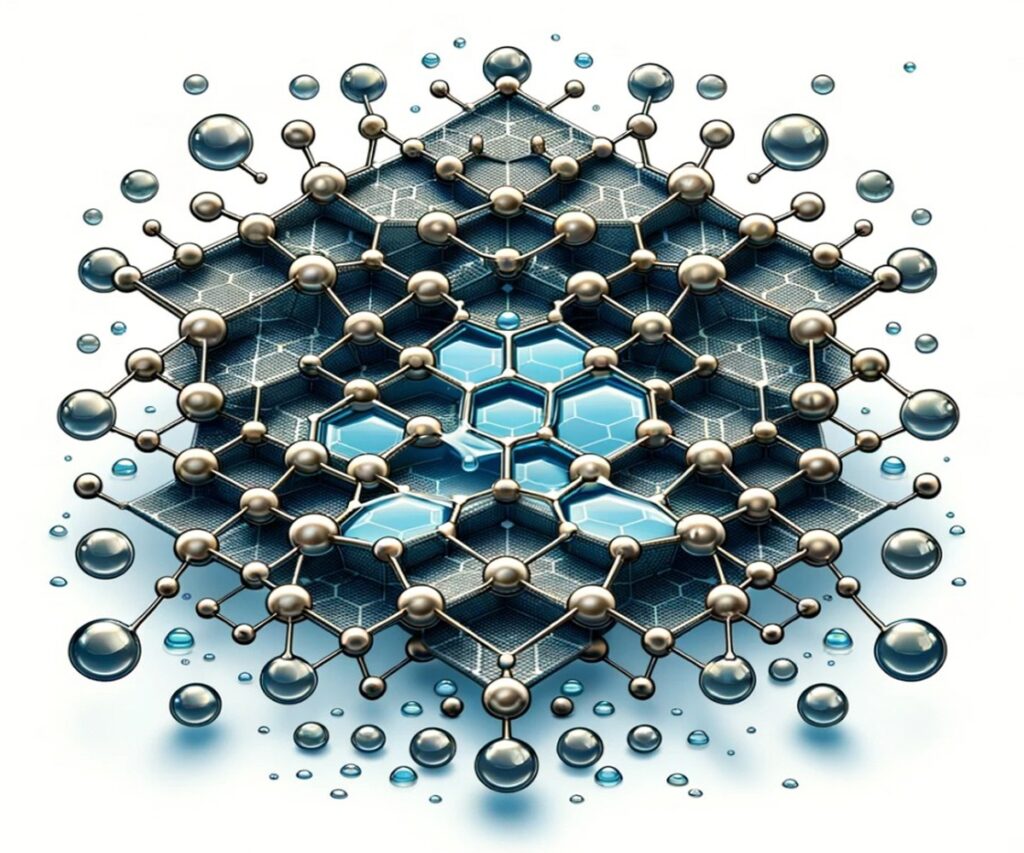Introduction: MXene
In the ever-evolving landscape of materials science, the discovery of two dimensional (2D) materials has ushered in a new era of innovation and possibilities. Among these groundbreaking materials, MXene, a tunable two-dimensional transition metal carbide, nitride, or denitride, has captured the attention of researchers worldwide. With its remarkable properties and vast potential applications, MXene is poised to revolutionize various industries, from electronics to energy storage. This two-dimensional material represents a paradigm shift in the way we approach material design and engineering, offering a world of possibilities for creating advanced technologies that could shape our future.

The Birth of MXene: A Serendipitous Discovery
The journey of MXene structure began with a serendipitous discovery during the research on titanium-aluminum-carbide (Ti3AlC2) at Drexel University, the pioneering institution in MXene research. Scientists selectively etched aluminum (Al) from the MAX phase precursor using hydrofluoric acid, revealing a two-dimensional planar structure of titanium carbide. This breakthrough marked the birth of MXene and ignited a new field of research into this remarkable two-dimensional material.

https://onlinelibrary.wiley.com/doi/abs/10.1002/adma.201102306
Unique Properties of MXene Structure
MXene exhibits a remarkable combination of properties that set it apart from other two-dimensional materials and traditional materials alike. Its high electrical conductivity, exceptional mechanical strength, and chemical inertness make it an attractive candidate for a wide range of applications. One of the most promising MXene structures, Ti3C2Tx, features a high density of oxygen vacancies, resulting in even higher electrical conductivity than existing MXene materials. This MXene structure’s characteristic makes it an ideal choice for high-performance electronic devices, energy storage applications, and beyond.
The unique properties of the MXene structure arise from its two-dimensional nature and the presence of surface terminations, which can be tailored to enhance specific properties. Researchers have been exploring various MXene structures, each with its own unique set of characteristics, to meet the demands of different applications.
For instance, the MXene structure composed of titanium and carbon, Ti3C2Tx, has attracted significant attention due to its exceptional electrical conductivity and hydrophilic nature. This MXene structure has shown promising results in applications such as supercapacitors, batteries, and electrochemical sensors, where high conductivity and surface area are crucial.
Another notable MXene structure is Nb2CTx, which exhibits excellent mechanical properties and thermal stability. This MXene structure has been investigated for use in structural composites, protective coatings, and high-temperature applications, leveraging its strength and resistance to extreme conditions.
The versatility of the MXene structure is further exemplified by the existence of MXene-based hybrid materials, where MXene is combined with other materials, such as polymers, metals, or ceramics. These hybrid MXene structures offer unique synergistic properties, opening up new avenues for advanced material design and application.
Moreover, the MXene structure can be tailored through various surface modifications, including functionalization, intercalation, and doping. These modifications can enhance specific properties, such as chemical reactivity, catalytic activity, or optical characteristics, enabling the MXene structure to be tuned for specialized applications in areas like catalysis, sensing, and optoelectronics.
As research on the MXene structure continues to advance, new opportunities for its practical implementation are emerging. From energy storage devices to electronic components, from composite materials to environmental remediation, the MXene structure is poised to revolutionize various industries with its exceptional properties and versatility.
Applications of MXene: A Material for the Future
The unique properties of MXene make it a versatile two-dimensional material with applications spanning various industries:
1. Electronics: MXene’s high electrical conductivity and mechanical strength make it an attractive candidate for next-generation electronic devices, such as flexible electronics, sensors, and energy storage solutions. Imagine bendable smartphones, wearable devices, and ultra-thin displays powered by the remarkable capabilities of this two-dimensional material.
2. Energy Storage: The two-dimensional nature of MXene and its high surface area make it an ideal material for supercapacitors and battery electrodes, enabling more efficient energy storage and faster charging capabilities. MXene could pave the way for longer-lasting batteries, rapid charging technologies, and more sustainable energy solutions.
3. Environmental Remediation: MXene’s chemical inertness and selective adsorption properties make it a promising two-dimensional material for water purification, air filtration, and environmental remediation applications. This versatile material could play a crucial role in addressing global environmental challenges, such as water scarcity and air pollution.
4. Catalysis: The unique structure of MXene and its ability to support catalytic nanoparticles make it a potential catalyst for various chemical reactions, including hydrogen production and fuel cell applications. By enhancing catalytic processes, MXene could contribute to the development of clean energy technologies and more efficient chemical processes.
5. Biomedical Applications: Researchers are exploring the potential of MXene in biomedical applications, such as drug delivery, biosensing, and tissue engineering. The two-dimensional nature of MXene, combined with its unique properties, could lead to novel biomedical solutions and advancements in healthcare.
Scaling Up MXene Production: Paving the Way for Commercialization
While the potential of MXene is undeniable, one of the significant challenges has been the scalability of its production. However, researchers at Drexel University and the Materials Research Center in Ukraine have made significant strides in this area by developing a scalable production system capable of producing large quantities of MXene while preserving its unique properties.
The team designed a lab-scale reactor system that can convert a ceramic precursor material into powdery black MXene titanium carbide in batches as large as 50 grams. This achievement represents a critical step towards achieving viability for manufacturing and widespread adoption of MXene in various applications.
Overcoming the scalability challenge is crucial for transitioning MXene from a laboratory curiosity to a commercially viable two-dimensional material. By demonstrating the ability to produce consistent and high-quality MXene on a larger scale, researchers are paving the way for its integration into real-world products and technologies.
Commercialization and Collaboration: Bridging the Gap Between Research and Industry
As the research on MXene continues to advance, companies such as Vorbeck and Grolltex are dedicated to exploring and commercializing two-dimensional materials, including MXene. These companies specialize in the research and development of 2D materials, recognizing their vast potential and the need for collaboration between academia and industry.
Successful commercialization of MXene requires a synergistic partnership between researchers, scientists, and industry experts. Academic institutions drive the fundamental research and exploration of new MXene structures and properties, while companies like Vorbeck and Grolltex focus on translating these discoveries into commercially viable products and applications.
Through collaborative efforts, the gap between research and industry can be bridged, fostering an ecosystem where scientific breakthroughs can be transformed into tangible solutions that benefit society. By combining academic excellence with industrial expertise, the path to realizing the full potential of MXene becomes more accessible.
The Future of MXene: Limitless Possibilities and a Sustainable Tomorrow
The future of MXene holds limitless possibilities as researchers continue to explore new structures, compositions, and applications of this remarkable two-dimensional material. As our understanding of MXene deepens, we can expect to witness groundbreaking innovations across various sectors, from electronics and energy storage to environmental remediation and catalysis.
Moreover, the unique properties of MXene align with the growing demand for sustainable and environmentally friendly technologies. This two-dimensional material could play a pivotal role in developing clean energy solutions, efficient resource utilization, and mitigating the impact of human activities on the environment.
Imagine a future where MXene-based technologies enable us to harness renewable energy sources more effectively, purify water through advanced filtration systems, and reduce our reliance on harmful chemicals and processes. The potential of MXene extends far beyond its immediate applications, offering a path towards a more sustainable and responsible approach to technological development.
※ This report has been compiled for the purpose of providing general information. It is based on data gathered by CHEMiFORGE. Should you have any inquiries or need to make decisions based on this report, it is advisable to consult with a CHEMiFORGE.


